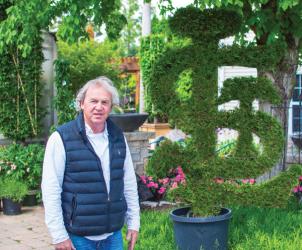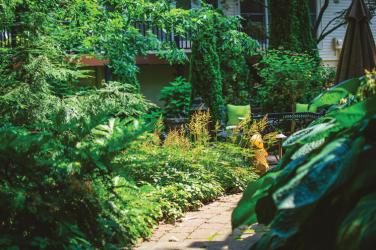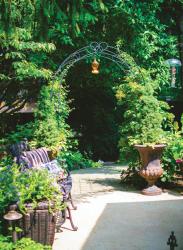SLHL: How did you get into the landscaping business?
Jim: I pursued a degree in horticulture. During the summer, I worked odd jobs doing landscaping. Then I started a business right out of college.
SLHL: How would you describe the soil in St. Louis?
Jim: Missouri soil, in general, tends to contain a lot of clay, which can cause drainage problems. The clay doesn’t allow water to run through it, so it can sometimes pool and cause plants to have too much water around the root system, causing root rot.
SLHL: What can a homeowner do to help them become a successful gardener?
Jim: As far as successful gardening goes, we tend to recommend people talk to the staff in our garden center. A lot of them out there are very well-versed in plant diseases and knowing what annuals and perennials are going to do well in certain areas. When it comes to landscaping and being able to grasp the whole picture, on-site consultations are preferred to be able to observe how and when the sun hits the area, what the drainage situation might be and if the area is prone to wildlife disturbing the landscape. Typical questions we get are about how well a certain plant may fit in an area in their yard. We ask mostly about how much sun the area gets and we can usually determine from there.
SLHL: When designing a landscape project for a client, what are the most important questions you ask the homeowner before starting the project?
Jim: How are they going to use the space? What are their long-term goals? Do they have any likes or dislikes with plant material?
SLHL: How hard is it to grow your own vegetables, and do you need to fence it in to keep pests (like rabbits and deer) out?
Jim: Again, our garden center has a wealth of information on this subject. They recommend using potting soil with a good amount of nutrients in it. Potting soil drains better. We do not recommend using straight topsoil for vegetable gardens as it is too thick. If any herbicides are used, we recommend organic types. A fence is highly recommended to keep pests out.
SLHL: If a homeowner wants to plant fruit trees in their landscape, what type of tree would you suggest? How many should be purchased, and do fruit trees need special care?
Jim: I would go with more of a dwarf fruit tree such as Espalier apple tree, these work well on a patio space and give flowering interest as well. Purchase number is up to the client. For care, proper pruning is a must.
SLHL: Is there a popular plant or tree that you wouldn't recommend in a St. Louis landscape?
Jim: The Bradford Pear is a messy tree. They can also be invasive, meaning they grow and spread aggressively and can cause environmental harm. The Bradford Pear is also a weak tree. They are prone to weak “joints” where the trunk and limbs connect which can result in large branches splitting during wind and/or storms. The bloom on this tree can often be foul.
SLHL: Is it best to purchase only native Missouri plant material?
Jim: I don’t believe so. It limits your plant palette and creates limitations and creativity in smaller spaces.
SLHL: What was one of your favorite landscaping projects and why?
Jim: One of them would be a large-scale project when a client was building a new house, detached garage and barn. The project included an outdoor living space complete with a kitchen, fireplace and patio. The project also included an entry monument. We got to use a lot of large-specimen plant material as well as work with the natural beauty and contours of the property. See stlouishomesmag.com for more information











